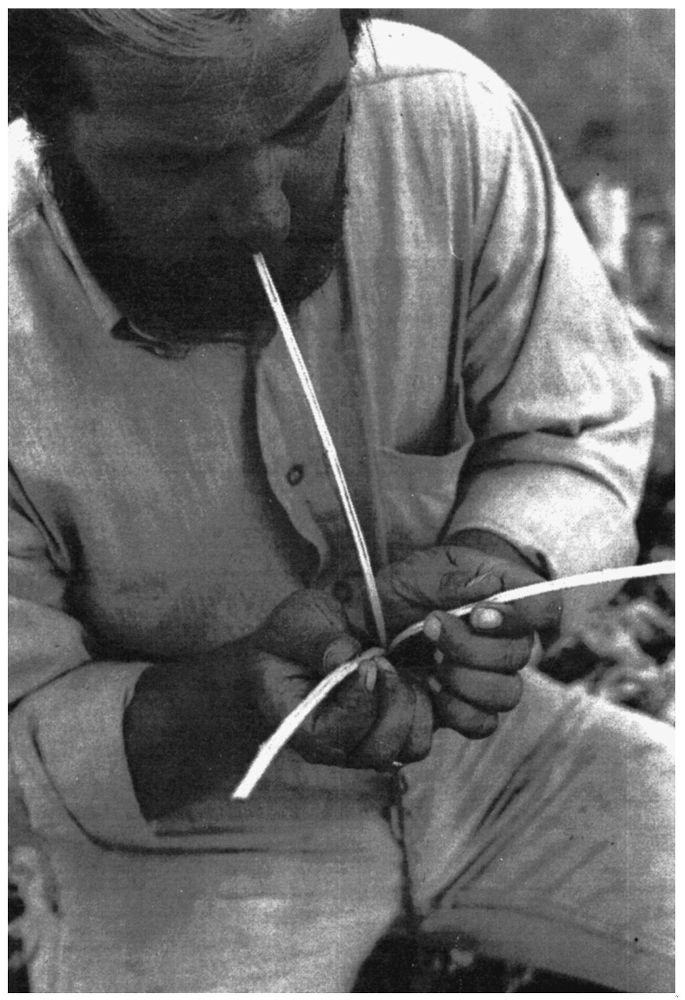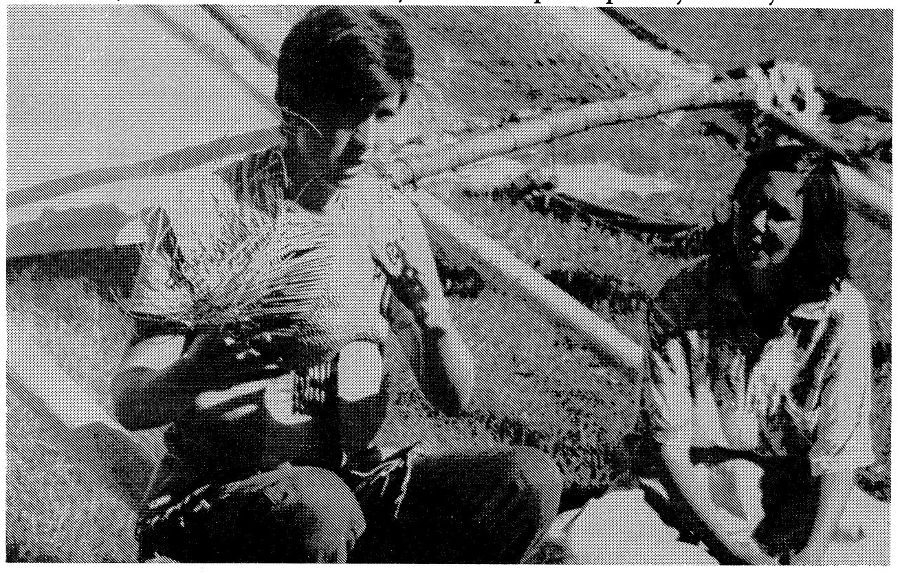
Richard Jamison demonstrates technique of splitting sumac splints into three thin weavers: Here he shows how to support and control the split using your hands or pinky fingers so that each weaver is the same thickness.
Northern beargrass is collected at high summer before the flower stalks begin to form. Reach into the center of the clump and pluck out the very center bunch of leaves. This includes the growing point. The plant won’t flower in the year you collect leaves, so skip around and leave some to flower. The small central leaves are the most flexible and dry pure white if laid in the sun for a few days. Turn them frequently so they don’t sunburn—they can become brittle and turn a dingy yellow. To reconstitute them for weaving, soak the leaves in warm water for 20 minutes and then wrap them in a damp towel while you work. Over-soaked beargrass turns grey and cracks. Some people remove the center vein of the leaf before using it to make it lie flatter. Be careful not to cut your hands on the sharp leaf edges.
Maidenhair or five-fingered fern has a beautiful shiny stem with a black side and a reddish side. The red side tends to be brittle and hard to work with, but some weavers save both sides. Pinch the fresh stem in your fingers or in a split stick and pull down the length of the stem to crack it along the line between the red and black sides. This can be tricky—the stems can spiral. Gently pull the sides apart and clean out the greenish center with your fingernail.
Wild cherry bark in the northwest is a beautiful shiny red, particularly up in the high branches where the wind rubs the boughs together. This natural polishing rubs off the dull grey outer film. Use a pruning saw to get at the high branches. Lower branches can be rubbed with a kitchen scrubber or horsetail rushes to polish up the red bark. Cut the branches at the leaf whorls. Make a small cut at the top to get a small tip of outer bark free. Then pull out and down at an angle to spiral off the outer bark in one piece. With some practice you can get a long strip about one-half-inch wide out of a single branch. The green inner bark can be treated as in the bark section. It is strong and beautiful but should not be used in any food processing baskets as it contains cyanide.
Chain ferns and some other ferns contain supportive filaments that run along inside the stems. These were described in the root section for the bracken fern. Filaments can be extracted by first removing the leaflets, then cracking the entire length of the stem by gently pounding it with a rock. Pull away the outer tissue and remove the two light green filaments. These are often dyed a rich orange brown with alder bark.
To make the dye, pound up some bark or grate the larger pieces to resemble grated carrots. Pour boiling water over about a cup of the bark in a bowl and allow it to steep and then cool for a few hours. Set your rolls of fern filaments or anything else you want to dye so that they are covered with liquid. You should see a change almost immediately. Some alders work better than others, but generally it is the exposure to air (oxidation) which brings out the rich color. After a few hours, wrap the filaments in a damp towel to fully oxidize. If you still don’t get a dark enough color, add a pinch of baking soda to the dye and try it again. Alder acts as a natural litmus solution (a blue coloring matter that is turned red by acids and can be restored to blue by alkalis). Alkali will darken the color and acid will lighten it. If you get it too dark, add a little vinegar.
Porcupine quills are used in fine twined basketry in California and Oregon as an overlay. They are usually dyed yellow, red or pink. Many natural dyes will take on quills, but by far the best is wolf lichen (Evernia vulpina), the bright chartreuse moss that hangs on the trees at high elevations. It has a natural mordant and can be used to enhance other dyes. Wash your quills well with a grease-cutting mixture such as urine or pine cleaner (your choice!). Place the quills and moss in a pan in alternating layers about an inch thick ending with a moss layer. Pour boiling water over the whole thing and bring it to a boil again. Quills don’t mind the heat. Set a plate in the pot to keep the quills under the liquid. Set the pot aside overnight and in the morning the quills will be bright yellow.
Try the following colors:
Shiny white or cream
northern beargrass (Xerophyllum tenax)
cane tops (Phragmites communis)
corn husk, rye grass (Elymus sp.)
Shiny black
maidenhair fern stems (Adiantum pedatum)
gold-back fern stem (Pityrogramma sp.)
deer fern stem (Blechnum spicant)
sea grass or eel grass
Orange brown
chain fern filaments (Woodwardia sp.)
dyed with alder bark (Alnus sp.)
cedar bark split very fine, spruce or cedar root skins
Shiny red
outer cherry bark, redbud skin (Cercis sp.)
Yellow
Porcupine quills or beargrass dyed with wolf lichen
dock root (Rumex sp.)
grape root
osage wood chips (Maclura pomifera)
rabbitbrush (Chrysothamnus nauseosus)
onion skins (Allium sp.)
You will notice I have listed some other dye materials. These are only the most commonly used dyes. Try getting books on dye plants and experimenting with the stronger outer fibers. Split willow, cedar and spruce roots, wood splints and yucca take natural dyes quite well.
Also try walnut (Juglans nigra) husks, iron shavings (or steel wool), marsh mud, or oak galls for dark brown or black. Bloodroot (Sanguinaria canadensis), willow bark and sand dock make other orange-reds. Spruce bark makes a nice lavender on rawhide. For greens and blues, try hawthorne berries, larkspur flowers (Consolida ambigua), pond scum algae, Queen Anne’s lace center flowers or bear’s hair lichen.
There are endless possibilities available for the modern basket maker. I have tried to summarize the traditional plant preparation methods I know about. There are many more plants out there to experiment on. Feel free to try these methods on any available plant parts you may find.

The author demonstrates and explains various basket weaving techniques indigenous to Native American cultures during a class at the Rabbit Stick Rendezvous. (Photo: Linda Jamison)
Ernest Wilkinson
Tracking Skills
Having coordinated search and rescue teams for many years, I can verify that a good tracking team, on the scene before a large group of ground searchers arrives, can save many hours and often the life of the victim(s).